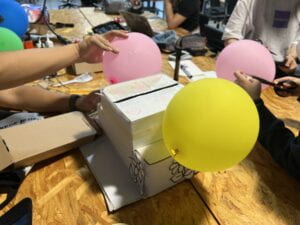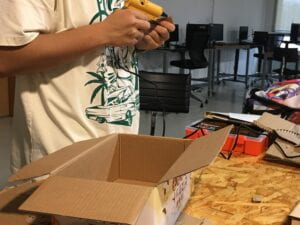Brainstorm
Our group was fascinated by “The Ones Who Walk Away From Omelas.” The story inspired us to reflect on the relationship between happiness and misfortune. Therefore, we decided to create an artifact based on it.
The happiness of Omelas is established on a boy’s excessive suffering. Only when seeing the boy in the dungeon suffering from all the filth and pain, can people in Omelas understand the happiness and value their “perfect” life. Therefore, we came up with the idea of a concrete representation of this abstract correlation in Omelas society instead of a product that can be used in everyday life. The device contains all the darkness of Omelas inside of it, yet on the surface, it presents happiness and celebration, which reflects the correlation. In short, we want to juxtapose and reproduce what happened in Omelas in a visual way.

Hands-on Making
How will we bring the idea to life? First, we wanted to use boxes as the symbol of the desperate and secluded environment where the boy is. We found two cupboard boxes and stuck them together as the basement in the story. It also serves as the skeleton of the device. Second, because of the depiction of a beautiful landscape in the story, we reify happiness as the flowers on the top of the device.
We need to find a way to make two things connected and interactive. I came up with the idea to dig a hole on the touching side of two boxes. And I could make the flowers go through the junction and stick the stem onto a piece of the cupboard which was limited inside of the lower box. Therefore, when the boy put on the device, the cupboard would be pushed up the flower could pop up out of the upper box. With this method, the relationship between happiness and misery could be established. The idea was approved by others.
Last, we used different colors to represent elements in the story, for example, black as jail and pink as the festival in Omelas.

Preliminary Explanation
We think the interactivity lies in the process of putting on the device. As Chris Crawford defines the interaction in his book, the boy inputs himself, or at least his head, into the device. The device processes the sign by putting the flowers out of the box and outputs the symbol of happiness.
Script
In the performance, we try to showcase the suffering of the boy and the people’s reaction to it.
In the beginning, the boy is chosen to put the device and suffer for the sake of all citizens in Omelas, following the beginning of the festival in Omelas.
Then, a family of three comes into the scene. The parents decide to reveal the dark secret to the girl. This scene represents the part of life that every citizen in Omelas must go through. Witnessing the boy’s suffering helps the new adults understand the root of Omelas.
Also, among all the people who have seen the boy, some souls can not tolerate the truth and walk away from Omelas. One of the team members will play the role who left after discovering the secret. The role represents the remaining conscience in some people.
The performance will end with the scene of the cheerful celebration in Omelas. The exhilaration in Omelas will last forever, and so will the suffering of the boy and children after him, contrasting with each other and generating uncomfortable yet meaningful experiences for the audience.
Teamwork and Casting
Our team was well-organized and every member had specific tasks to finish.
During the preparation, Claire and Dana were responsible for generating ideas and considering the deep meaning of our artifact. I took on the hands-on making. I made the important components for our device. Rachel, Jenna, and Alaia took the leading responsibility of decorating and embellishing the device. Their job is vital because we use colors to represent and the appearance of the device matters.
The communication in our team went extremely well. Claire and Dana would present the idea to the whole group, and we would do our job accordingly. When we had new ideas, we would have a discussion with other members of the team and together we decided whether to implement them.
In casting, as the only male in the group, I played the role of the suffering boy in Omelas. Jenna, Rachel, and Alaia played an ordinary yet representative family in Omelas. Claire played the one who walks away from Omelas. Dana’s role stood for the normal people that pay a visit to the boy and enhance their understanding.
Performance and Reflection
In the performance, we finished all the basic tasks. The bright side of our project is that we dare to challenge what other groups did not dare to challenge. We used a representation of an abstract correlation to fulfill the requirement instead of a concrete product. Ideally, it is definitely harder but it will prompt more in-depth thinking. Our performance sticks to the story plot and shows a deep connection with it.
However, the performance is far from satisfactory to me.
First, we did not pay enough attention to the opening. It was not well planned and ended up with me holding the device instead of others. If the device had been held by others and they had worn it for me, it would be better for the audience to understand the nonvoluntary sacrifice the boy made.
Second, we failed to convey the idea to the audience and stimulate them to reflect. When we chose a representation instead of a product for this project, we did not foresee that the abstract concept is hard to express explicitly. It led to plenty of questions from the audience after the ending, which clearly shows that the main idea of the story was not well explained. I think the lesson learned from this is that we should employ more concrete plots and create more dramatic contrasts on the stage.
Last, we still lacked an understanding of interaction. The failure in storytelling has a strong connection with the device itself. After I watched other groups’ performances, I think the interaction concept in our device is quite far-fetched. If communication between the device and the human had been more involved in the performance, the main idea would become more understandable.
Assessment of Another Performance
The performance given by Kenneth Chu’s group left a deep impression on me.
The prototype they created is a crown-like wearable device. It is based on the same story as ours, “The Ones Who Walk Away From Omelas.” It can control the user’s emotions and change their opinion and attitude toward others, which reminds me of the Penfield Mood Organ in the novel “Do Androids Dream of Electric Sheep” by Philip K. Dick. Their prototype was creative, novel, and most importantly, interactive enough.
As for the performance, they involved different scenarios where people could use the device. It is understandable and fun to watch at the same time.
However. the weakness of the performance is that there is little connection between the product and the story on which they based the project. The story has a unique understanding of the correlation between happiness and misery as I previously demonstrated. Their performance diminishes the existence of the story. Their product did not shine a highlight on it and wandered away elsewhere. It is not characteristic enough, so it can even fit in the narrative of the other two stories as well.
My suggestion for them is that they should contemplate more on the deep meaning of the story and try to make the product more related. For example, the device can only be used to infuse the emotions of the Omelas boy so that people can show more sympathy for him.